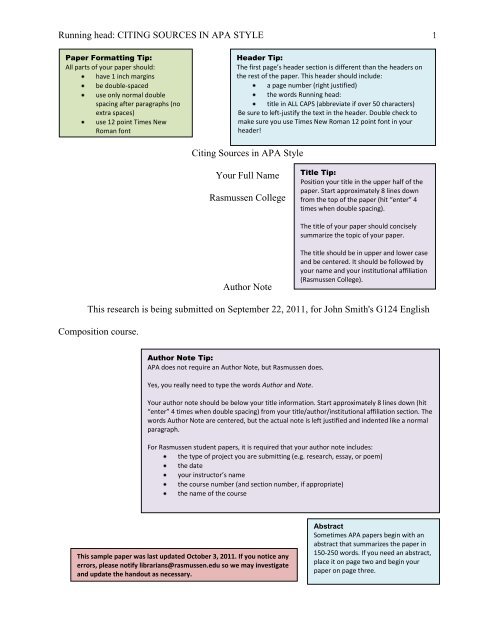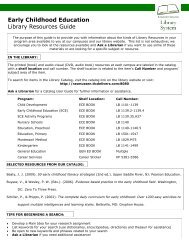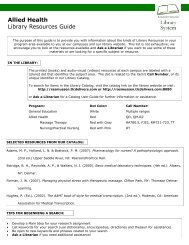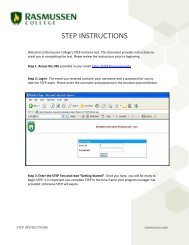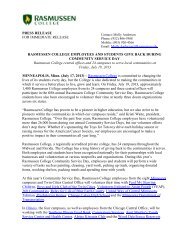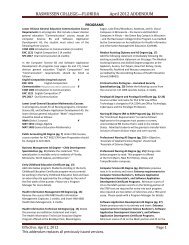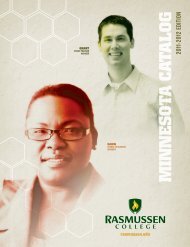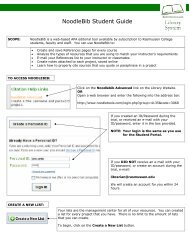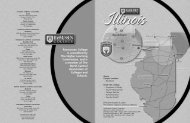CITING SOURCES IN APA STYLE - your Student Portal!
CITING SOURCES IN APA STYLE - your Student Portal!
CITING SOURCES IN APA STYLE - your Student Portal!
- No tags were found...
Create successful ePaper yourself
Turn your PDF publications into a flip-book with our unique Google optimized e-Paper software.
Running head: <strong>CIT<strong>IN</strong>G</strong> <strong>SOURCES</strong> <strong>IN</strong> <strong>APA</strong> <strong>STYLE</strong> 1Paper Formatting Tip:All parts of <strong>your</strong> paper should:have 1 inch marginsbe double-spaceduse only normal doublespacing after paragraphs (noextra spaces)use 12 point Times NewRoman fontHeader Tip:The first page’s header section is different than the headers onthe rest of the paper. This header should include:a page number (right justified)the words Running head:title in ALL CAPS (abbreviate if over 50 characters)Be sure to left-justify the text in the header. Double check tomake sure you use Times New Roman 12 point font in <strong>your</strong>header!Citing Sources in <strong>APA</strong> StyleYour Full NameRasmussen CollegeTitle Tip:Position <strong>your</strong> title in the upper half of thepaper. Start approximately 8 lines downfrom the top of the paper (hit “enter” 4times when double spacing).The title of <strong>your</strong> paper should conciselysummarize the topic of <strong>your</strong> paper.Author NoteThe title should be in upper and lower caseand be centered. It should be followed by<strong>your</strong> name and <strong>your</strong> institutional affiliation(Rasmussen College).This research is being submitted on September 22, 2011, for John Smith's G124 EnglishComposition course.Author Note Tip:<strong>APA</strong> does not require an Author Note, but Rasmussen does.Yes, you really need to type the words Author and Note.Your author note should be below <strong>your</strong> title information. Start approximately 8 lines down (hit“enter” 4 times when double spacing) from <strong>your</strong> title/author/institutional affiliation section. Thewords Author Note are centered, but the actual note is left justified and indented like a normalparagraph.For Rasmussen student papers, it is required that <strong>your</strong> author note includes:the type of project you are submitting (e.g. research, essay, or poem)the date<strong>your</strong> instructor’s namethe course number (and section number, if appropriate)the name of the courseThis sample paper was last updated October 3, 2011. If you notice anyerrors, please notify librarians@rasmussen.edu so we may investigateand update the handout as necessary.AbstractSometimes <strong>APA</strong> papers begin with anabstract that summarizes the paper in150-250 words. If you need an abstract,place it on page two and begin <strong>your</strong>paper on page three.
TitleTip:The titleshould bein upperand lowercase andcenteredat thebeginningof <strong>your</strong>paper. Itshouldnot bebolded.Header Tip:<strong>CIT<strong>IN</strong>G</strong> <strong>SOURCES</strong> <strong>IN</strong> <strong>APA</strong> <strong>STYLE</strong> The header section is different than the header on the title page. 2While it does include the title and page number, it does NOT includethe words Running head:Citing Sources in <strong>APA</strong> StyleA basic paper consists of an introduction, body, and conclusion. The introductoryparagraph introduces <strong>your</strong> topic and typically summarizes <strong>your</strong> main points and ends with athesis statement. The body of <strong>your</strong> paper should address each of <strong>your</strong> main points and include<strong>your</strong> own insights or conclusions. Each of <strong>your</strong> points should be supported by facts, statistics, orexamples you found during <strong>your</strong> research. When you are sharing information in <strong>your</strong> paper thatis not <strong>your</strong> own original insight, you need to include both an in-text citation and a matching entryin <strong>your</strong> references page to give credit to the original author of the idea. Your paper shouldinclude direct quotes and paraphrases or summaries of information from <strong>your</strong> sources. This paperexplains in detail the many types of in-text citations and the importance of creating them usingcorrect <strong>APA</strong> formatting.Types of In-Text Citations for Paraphrases and SummariesIn-text citations are shortened versions of the information in <strong>your</strong> reference list and aredesigned to be minimally disruptive to the flow of <strong>your</strong> writing. That is why in-text citationstypically include only the last name(s) of the author(s) and the year. In-text citations are usedwhen you paraphrase, summarize, or otherwise put information you have learned during <strong>your</strong>research into <strong>your</strong> own words. The first two in-text citations in this paper are examples of howto utilize in-text citations when you are paraphrasing or summarizing. The first citation appearsat the end of the next sentence. To create a citation of this type, place last name(s) of theExample ofa heading.Noticethat it isbothcenteredand bold.Subheadings,if present,areformattedthe samewayexceptthey areleftaligned. Inaddition, ifyou usesubheadings,you musthave atleast two.author(s), a comma, and the year of publication at the end of the sentence (Amato, 2009). Noticethe comma and space after the author‟s last name and notice that the period for the sentence isafter the final parenthesis. The second citation in this paper includes the author‟s name as part ofthe sentence, this helps to vary <strong>your</strong> writing style. Notice that when this happens, only the yearIn-text citation at end of sentence. Notice that the end of sentence punctuation follows the citation. Check theReferences page of this paper to see the matching Amato reference. All in-text citations must match the firstword or words (generally authors’ last names) and year of their corresponding reference items.
<strong>CIT<strong>IN</strong>G</strong> <strong>SOURCES</strong> <strong>IN</strong> <strong>APA</strong> <strong>STYLE</strong> 3of publication is placed in parentheses. According to Robins (2009), once you have included acitation like this, you can from then on refer to the author without using the date when theauthor is part of the sentence. Robins notes you must be sure <strong>your</strong> reader will not be confusedwith another author cited elsewhere in <strong>your</strong> paper. Finally, note that if you use a parentheticalreference at the end of the sentence, <strong>your</strong> author‟s name must always be followed by the date.Types of In-Text Citations for Direct QuotesA second situation when an in-text citation is needed is when you use the exact words of<strong>your</strong> source, or a direct quote. Direct quotes need to be enclosed in quotation marks. The nextsentence contains a direct quote. Amato (2009) notes that <strong>APA</strong> requires a quote to be “inquotation marks to indicate that it is indeed a quote, rather than a paraphrase” (p. 60). You willnotice that this type of citation is different from the in-text citations for paraphrases andsummaries because it includes the page number where the words in quotations can be located. Aquotation from a web page should include the paragraph number if there are no page numbers.Notice <strong>APA</strong> uses the abbreviation of p. for page and para. for paragraph and that there is a spaceIn-textcitationfor aquoteincludesquotationmarksand thepagenumber.between the p. or para. and the actual page number.In-Text Citations with Multiple AuthorsIf you have information from a resource with two authors, you list both authors within thein-text citation. The authors‟ last names are separated with the ampersand sign (&), not the wordand. Here is an example of how an end-of-sentence citation would look for a paraphrase: (Roen,Glau & Maid, 2009). It is important to note that if you mention the authors within the sentencerather than in parentheses, you should identify them using the word and, not &. This type of intextcitation will look like this: Roen, Glau, and Maid (2009) note that “proper documentation ofIn-textcitationforthreeauthors.Two,four andfiveauthorsarehandledin thesamemannerthe firsttime thesourceis cited.
<strong>CIT<strong>IN</strong>G</strong> <strong>SOURCES</strong> <strong>IN</strong> <strong>APA</strong> <strong>STYLE</strong> 4appropriate sources lends ethos and credibility to you as a writer and enhances <strong>your</strong> argument”(p. 532).If you have six or more authors, <strong>your</strong> in-text citation will look like this: (Kent et al.,2010). If you have three to five authors, the first time you cite them, <strong>your</strong> citation will list all ofthe authors; all subsequent citations will list only the first author, like the Kent citation above.Creating in-text citations for sources with many authors can be confusing. Table 1 will help youcite <strong>your</strong> authors correctly.Table 1In-text citation for six or more authors. Sources with three to fiveauthors follow this example after they have been cited once.In-Text Citation of Various Numbers of AuthorsItalicizethe titleof thetableand thewordNote.Note. Taken from Publication Manual of the American Psychological Association (6 th ed., p.177), 2010, Washington D.C.: American Psychological Association. Copyright 2010 by theAmerican Psychological Association. Reprinted within <strong>APA</strong>‟s allowable use guidelines.In-Text Citations for Online SourcesResearching information for a paper may involve the use of the Internet. Information cancome from a web page or it may come from an online source such as a subscription database.The in-text citation for a web page will include the author and the date of publication. If there is
<strong>CIT<strong>IN</strong>G</strong> <strong>SOURCES</strong> <strong>IN</strong> <strong>APA</strong> <strong>STYLE</strong> 6except as a typographical nicety‟ ” (Klein, 2011, p. 1). Notice that Klein‟s words are in doublequotation marks and the words from CMS are in single quotation marks. Only Klein is in thereferences list at the end of the paper. The Chicago Manual of Style is not.Block QuotesBlock quotes are used for any direct quotes that are 40 words or more. If you have such along quotation, you will want to introduce it and block indent the whole quotation. Blockquotations do not have quotation marks surrounding them because the block indent tells thereader it is a quotation. An example of a block quote follows:Place direct quotations longer than 40 words in a free-standing block of typewritten lines,and omit quotation marks. Start the quotation on a new line, indented 1/2 inch from theleft margin, i.e., in the same place you would begin a new paragraph. Type the entirequotation on the new margin, and indent the first line of any subsequent paragraph withinthe quotation 1/2 inch from the new margin. Maintain double-spacing throughout. Theparenthetical [in-text] citation should come after the closing punctuation mark. (Angeli etal., 2011, para. 27)Block quotes should be used sparingly. Do not use them as space fillers!Personal CommunicationsPersonal communications include information that is not retrievable, such as phoneconversations, interviews, email, memos, and personal letters. Personal communications areunique in <strong>APA</strong> because they are cited in-text but do not have a corresponding entry in thereferences list. An example of a personal communication in-text citation might look like this:According to L. Harrington (personal communication, February 22, 2011), interviews includedin papers need to be relevant.
<strong>CIT<strong>IN</strong>G</strong> <strong>SOURCES</strong> <strong>IN</strong> <strong>APA</strong> <strong>STYLE</strong> 7The end of <strong>your</strong> paper should be <strong>your</strong> references list. It is a separate page in which youprovide complete information about each item cited in-text so that <strong>your</strong> readers can find it fortheir own use. You should have at least one in-text citation in <strong>your</strong> paper for each item in <strong>your</strong>references list. If you do not, make sure to include one or remove the item from the referencelist. Finally, each in-text citation must have a matching reference listing, except for personalcommunications that are referred to within the text of <strong>your</strong> paper only.References Page Tips:Note these features of the references page:The references page always begins on its own page at the end of the paper.The references page begins with the word References, which is centered at the top of the page.All sources are listed alphabetically by the first word in the reference (usually the author’s last name).Hanging indents should be used so that the second line of the reference (if present) is indented.DOIs for journal articles should be used if they exist. You might find DOIs for articles listed in the database you found them in, on thearticles themselves, or via the use of http://www.CrossRef.org. For more information, please see the library’s handout on DOIs.All <strong>APA</strong> references are put together in the same way with the same information and in the same order:Who did it (author, artist, director, organization, etc.)o Note: sometimes there is no author, in this case, the title goes in the author’s place.When they did it (publication or creation date)What they did (title)How to get it (varies based on type of source)o Place of publication and name of publishing company for bookso periodical title, volume, issue, and page numbers for journalso periodical title, volume, issue, page numbers, and doi or journal url for online journalso periodical title, date, and page numbers for newspapers and magazineso periodical title, date, page numbers, and doi or magazine/newspaper url for online newspapers and magazineso URL or web address for web pagesOnce you have a basic understanding of how reference items are put together, use the Rasmussen College Library’s subscription toNoodleTools’ NoodleBib software to prepare, format, export, and/or print <strong>your</strong> reference page.Note: Microsoft Word 2010’s reference formatting feature does NOT create correct <strong>APA</strong> 6 th edition references.
Header Tip:Note that the references page includes a title and page numberin the header, just like all the other pages in the paper.<strong>CIT<strong>IN</strong>G</strong> <strong>SOURCES</strong> <strong>IN</strong> <strong>APA</strong> <strong>STYLE</strong> 8ReferencesAmato, C. J. (2009). The world’s easiest guide to using the <strong>APA</strong> (4 th ed.). Corona, CA: Stargazer.American Psychological Association. (2010). Publication manual of the American PsychologicalAssociation (6 th ed.). Washington D.C.: Author.Angeli, E., Wagner, J., Lawrick, E., Moore, K., Anderson, M., Soderland, L., ... Keck, R. (2011,Feb. 3). Reference list: Electronic sources. Retrieved fromhttp://owl.english.purdue.edu/owl/resource/560/10/<strong>APA</strong> in-text citation guidelines. (2011). Retrieved fromhttp://www.ggu.edu/university_library/research_assistance/research_assistance_citing_sources/apa_in_text_citation_guidelinesKent, R. M., Friedman, R., Goodwyn, R., Hafner, A. W., Long, M. J., Kessinger, J., ...Weintraub, T. S. (1989). Plagiarism and confidentiality in the high school library.American Libraries, 20(4), 291. Retrieved from http://americanlibrariesmagazine.org/Klein, S. (2011, March 11). Single quotes within double quotes [Web log post]. Retrieved from<strong>APA</strong> Style: http://blog.apastyle.org/Robins, J. (2009). The first word: A letter from the publications editor. Journal of AdvancedAcademics, 21(1), 5-7. Retrieved from http://www.jaa.uconn.edu/Roen, D., Glau, G. R., & Maid, B. M. (2009). Writing for college, writing for life. Boston, MA:McGraw-Hill Higher Education.


